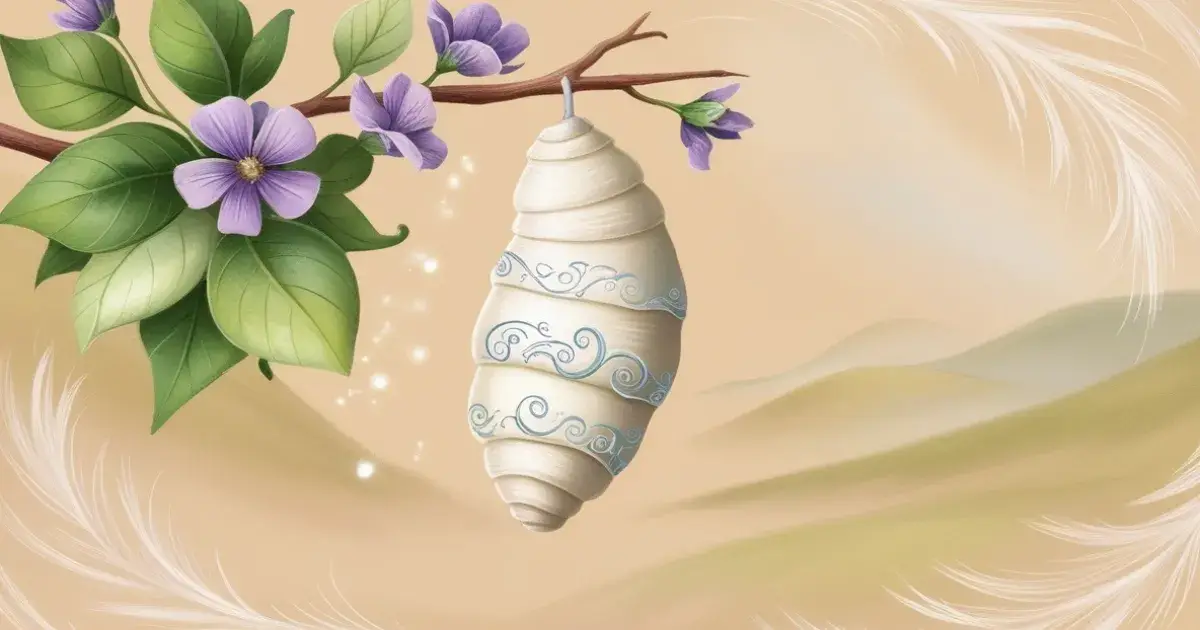Have you ever wondered if you should write “cacoon” or “cocoon”? If you’ve stumbled upon both terms and found yourself confused, you’re not alone! While they may look similar at first glance, these two words have distinct meanings and usage, which can affect the clarity of your writing.
In this article, we’ll explore the difference between cacoon or cocoon, providing you with the clarity you need to use the correct term confidently.
Why is the Confusion Between Cacoon and Cocoon Important?
Spelling mistakes can be a common hurdle in everyday writing, and understanding the correct usage of similar-sounding words like “cacoon” and “cocoon” can save you from potential embarrassment or confusion.
You may have seen both terms used in various contexts, whether discussing the lifecycle of insects, personal growth metaphors, or even in botany. Getting it right is crucial because it not only helps you communicate more clearly but also ensures that you are using words with proper definitions and meanings.
Short Answer: The correct spelling is “cocoon.” “Cacoon” is typically a misspelling or an incorrect variation of “cocoon”.
Definitions and Usage
What is a “Cacoon”?
Cacoon is an incorrect variant of “cocoon.” However, the term cacoon can occasionally be seen used in very specific contexts, such as in botanical discussions referring to Fevillea cordifolia, a medicinal plant used in traditional medicine. It may also appear as a typographical error in everyday language, causing confusion between the two words.
Example:
- “The cacoon plant, known for its medicinal properties, grows in tropical regions.”
As shown in the example above, cacoon in this case refers to a specific plant in the botanical domain and has little to do with the insect world.
What is a “Cocoon”?
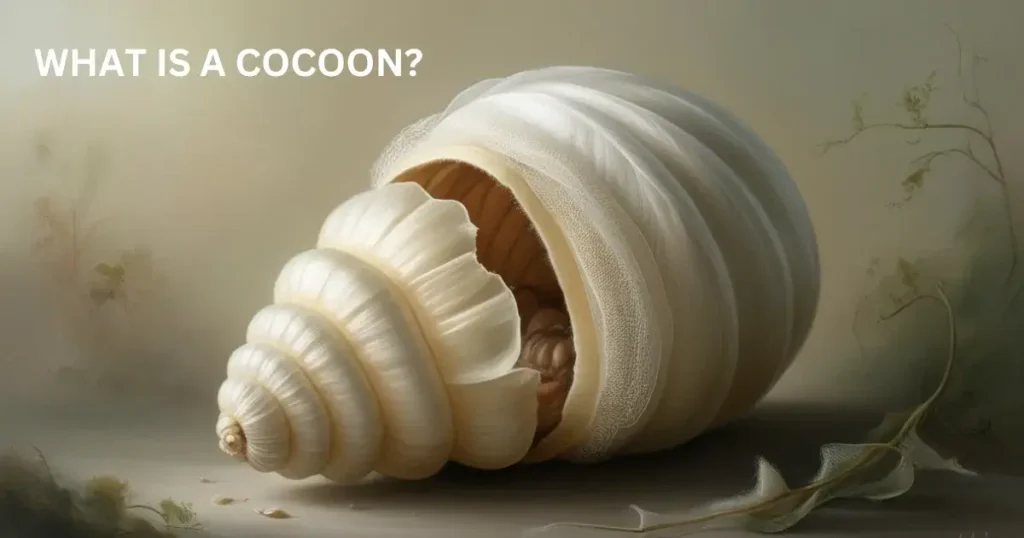
Cocoon, on the other hand, has a well-defined meaning in both entomology and figurative speech. In the world of insects, a cocoon refers to a protective casing spun by larvae, typically moths, or butterflies, as they transition into the pupal stage.
In a broader sense, “cocoon” is also used metaphorically to describe a state of isolation, comfort, or personal transformation—often referring to someone retreating from the world for self-reflection.
Example:
- “The caterpillar weaves a cocoon around itself during metamorphosis.”
- “She spent the weekend cocooning in her apartment, enjoying some much-needed solitude.”
Common Uses of “Cacoon”
While “cacoon” isn’t an officially recognized word in standard English dictionaries, it frequently appears as a misspelling of “cocoon.” The confusion usually arises due to the similarity in pronunciation and the visual similarity of the two words, particularly when typed quickly or without careful proofreading. Here are some common ways “cacoon” tends to be used mistakenly:
1. In Social Media Posts
On platforms like Twitter, Facebook, or Instagram, spelling errors are often more frequent due to the informal nature of the medium and the speed at which people post content. A word like “cocoon,” which has a somewhat unusual spelling, is a prime candidate for mistakes. Users might type “cacoon” without realizing it. This can lead to confusion, especially when others read or comment on the posts.
Example Mistake:
- “The caterpillar made a cacoon to protect itself from predators.”
(Correct: “cocoon”)
Here, the mistake occurs because the writer intended to use “cocoon” but typed “cacoon” without noticing the spelling error. Despite this, readers might understand the intended meaning but it diminishes the overall professionalism of the post.
2. Casual Writing or Texting
In more casual forms of writing, such as texting or emails between friends, people often use “cacoon” instead of “cocoon.” In informal conversations, particularly when writing quickly, the importance of accurate spelling is often overlooked. Additionally, autocorrect features on mobile devices may not always catch this particular mistake, allowing “cacoon” to slip through.
Example Mistake:
- “I’m staying inside my cacoon this weekend to relax and unwind.” (Correct: “cocoon”)
3. In Creative or Informal Writing
Sometimes, even in more creative pieces or blogs, the word “cacoon” appears as a mistake when referring to the protective structure of insects like moths and butterflies. Writers who focus on metaphorical uses of the word, such as personal growth or isolation, might accidentally slip into using the wrong spelling. In some instances, this can even happen while describing a cocoon in the context of metaphor, blurring the lines between the literal and figurative meanings.
Example Mistake:
- “She went into her cacoon and disconnected from the outside world for a while.” (Correct: “cocoon”)
This is particularly common in first drafts, where a writer may not be fully focused on the spelling. In casual blog posts, personal stories, or even creative fiction, this kind of mistake can happen, especially if the writer is more concerned with conveying an emotional message rather than technical accuracy.
Common Uses of “Cocoon”
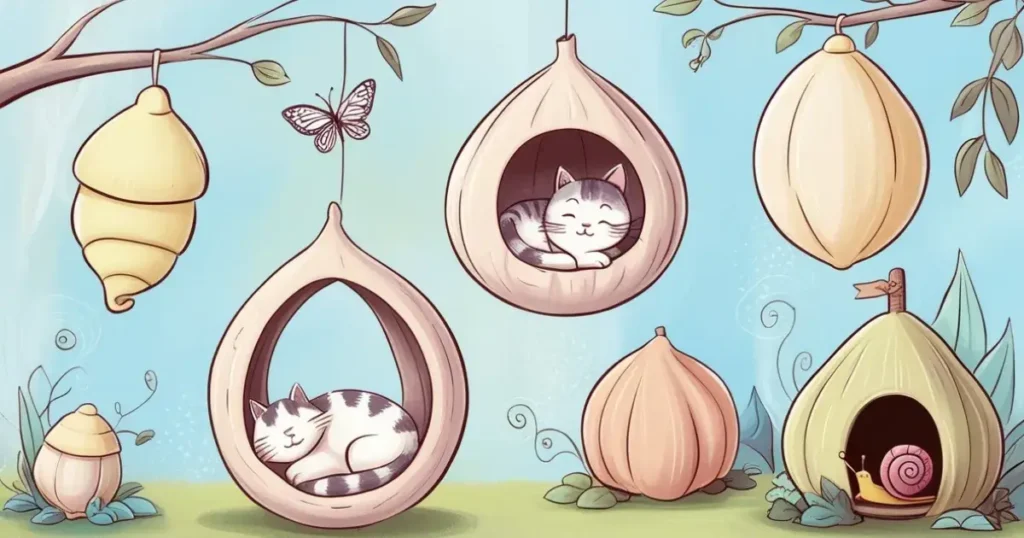
Unlike “cacoon,” the word “cocoon” has both literal and metaphorical uses. It is a well-established term in the English language, frequently used to describe a protective casing produced by certain insects like moths and caterpillars during their metamorphosis. Additionally, “cocoon” has grown to have metaphorical meanings in various contexts, such as personal growth, isolation, or comfort.
1. Literal Use of “Cocoon”
The primary, literal definition of “cocoon” refers to the silk or protective covering that some insects, notably moths and caterpillars, spin around themselves during the pupal stage of their life cycle. During this period, they undergo metamorphosis as they transition from larvae to adult forms. The term “cocoon” is thus frequently encountered in biology, entomology, and scientific discussions related to insects.
Example Literal Use:
- “A moth spins a cocoon around itself to protect itself while undergoing metamorphosis.”
In this case, the “cocoon” serves as a biological structure that provides protection during a crucial transformation period. It is typically associated with moths but can also be used in a broader context to describe the protective casings of other insects.
2. Metaphorical Use of “Cocoon”
Beyond the biological realm, “cocoon” is commonly used metaphorically to describe a state of isolation, comfort, or personal transformation. People might refer to themselves or others as “cocooning” when they retreat from the outside world for rest, reflection, or self-care. This metaphorical use plays on the idea that just as a caterpillar must retreat into its cocoon to undergo a profound change, humans might similarly retreat to heal, reflect, or grow.
Example Metaphorical Use:
- “He’s cocooning in his apartment this weekend to recharge after a stressful work week.”
- “After the difficult breakup, she spent a lot of time cocooning, focusing on her own emotional recovery.”
In both cases, the term is used to indicate that someone is deliberately withdrawing from their usual social or external activities for rest and personal growth.
3. “Cocoon” in Popular Culture
The metaphor of the “cocoon” has also appeared widely in literature, movies, and other media. For example, in the 1985 film Cocoon, the central theme revolves around the concept of rejuvenation, where the older people characters experience a transformation after entering an alien cocoon. This usage illustrates the metaphorical potential of the word, drawing from the real-world concept of metamorphosis and applying it to human experiences.
Example Use in Popular Culture:
- “In the movie Cocoon, the characters experience a rebirth-like transformation, much like the metamorphosis of a caterpillar emerging from a cocoon.”
Key Differences: Cacoon or Cocoon?
| Aspect | Cacoon | Cocoon |
|---|---|---|
| Definition | A misspelling of “cocoon” or a term in botany (rare). | A protective covering formed by insects during metamorphosis. |
| Common Usage | Rare; usually a mistake. | Commonly used in entomology, biology, and metaphorically. |
| Context | Typically seen in informal writing or casual posts. | Widely used in scientific discussions and metaphoric language. |
| Common Mistakes | Typographical error or confusion. | N/A—commonly used and accepted spelling. |
Common Questions: Cacoon or Cocoon?
When it comes to the terms “cacoon” and “cocoon,” the confusion is understandable. Most of the time, “cacoon” is simply a misspelling of “cocoon,” which is the correct term. Here are some of the most frequently asked questions related to “cacoon or cocoon” to help clear up any confusion.
Cacoon or Cocoon Butterfly?
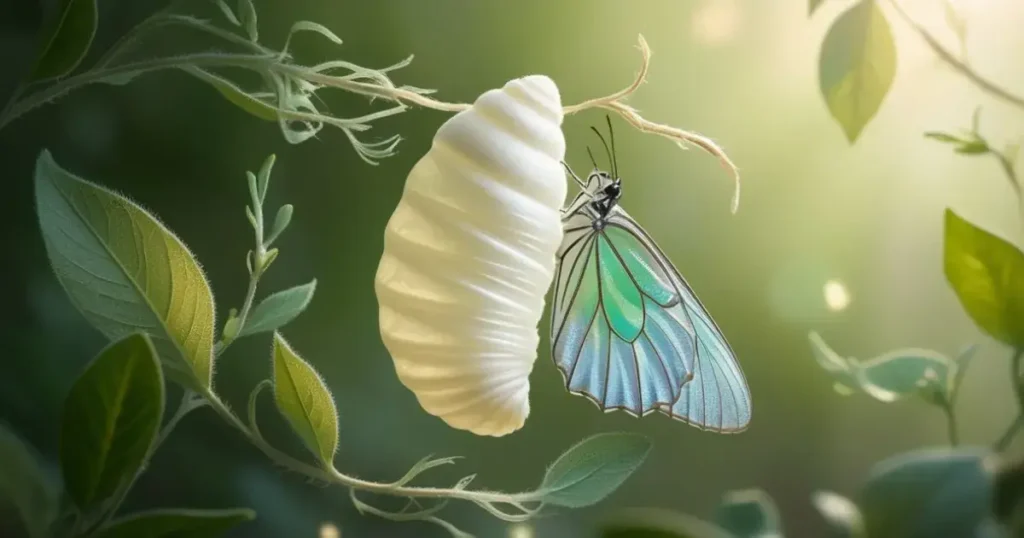
One common confusion is the use of “cacoon” in reference to butterflies. People often mistakenly refer to the structure that a butterfly forms as a “cacoon”, when in fact, butterflies do not make cocoons.
- Cocoon vs. Chrysalis: The term “cocoon” is specifically used for the protective covering spun by moths and some other insects, while butterflies create a chrysalis.
- A cocoon is usually made of silk, produced by moth larvae, and it covers the pupa during metamorphosis.
- A chrysalis (the pupa of a butterfly) is a more hardened, shell-like casing, but unlike a cocoon, it isn’t made of silk.
To clarify, the “cocoon” belongs to moths, while butterflies go through their pupa stage inside a chrysalis.
Example:
- “The moth spun a cocoon to protect itself, while the butterfly formed a chrysalis.”
This distinction is important because it helps accurately describe the life cycle of these insects.
Living in a Cocoon: What Does it Mean?
The phrase “living in a cocoon” can be interpreted both literally and metaphorically, depending on the context.
Literal Meaning:
In a literal sense, “living in a cocoon” refers to the actual stage in an insect’s lifecycle. For moths, caterpillars, and certain other insects, a cocoon is a protective casing they create around themselves as they undergo metamorphosis. During this period, the insect is completely enclosed, often immobilized, and in a state of transformation.
Metaphorical Meaning:
Metaphorically, “living in a cocoon” often refers to a state of withdrawal, isolation, or self-imposed seclusion. People might use this expression when they are taking time for themselves, retreating from the outside world to rest, reflect, or heal—much like an insect in its cocoon stage, where it is temporarily cut off from its environment to undergo a transformation.
Example Sentences:
- Literal: “The caterpillar was living in its cocoon, preparing to emerge as a butterfly.”
- Metaphorical: “After a tough few months, she’s living in a cocoon, focusing on her own well-being.”
In both senses, the term implies a protective or transformative state, whether biological or psychological.
How to Pronounce Cocoon
The correct pronunciation of “cocoon” is /kəˈkuːn/, which sounds like “kuh-KOON.” The first syllable is short and unstressed, while the second syllable is longer and stressed.
Tips for Avoiding Mispronunciations:
- Focus on the long “oo” sound in the second syllable.
- Avoid pronouncing it like “cuh-coon” (with a short “oo”).
- A good way to remember it is by associating it with the word “balloon,” which has a similar vowel sound in the second syllable.
To reinforce this, you could practice saying the word out loud, paying attention to the stress on the second syllable.
Moth Cocoon: What Is It?
A moth cocoon is a silk casing that moth larvae (caterpillars) spin around themselves in order to protect themselves during their pupal stage. Inside this cocoon, the caterpillar undergoes metamorphosis, transitioning into an adult moth. The cocoon acts as a physical barrier that shields the developing moth from predators and environmental threats during its vulnerable transformation period.
Why It’s Important to Use the Term “Cocoon” Correctly:
It’s crucial to use the term “cocoon” correctly when discussing the life cycle of moths because it is specific to certain types of insects (primarily moths) that create this silk structure. Misusing the word in reference to other insects like butterflies can lead to confusion.
Example:
- “The moth cocoon is often made from silk that the caterpillar secretes, creating a safe environment during the pupal stage.”
This distinction is significant because it reflects the differences in how various insects undergo metamorphosis.
Cocoon vs. Chrysalis: What’s the Difference?
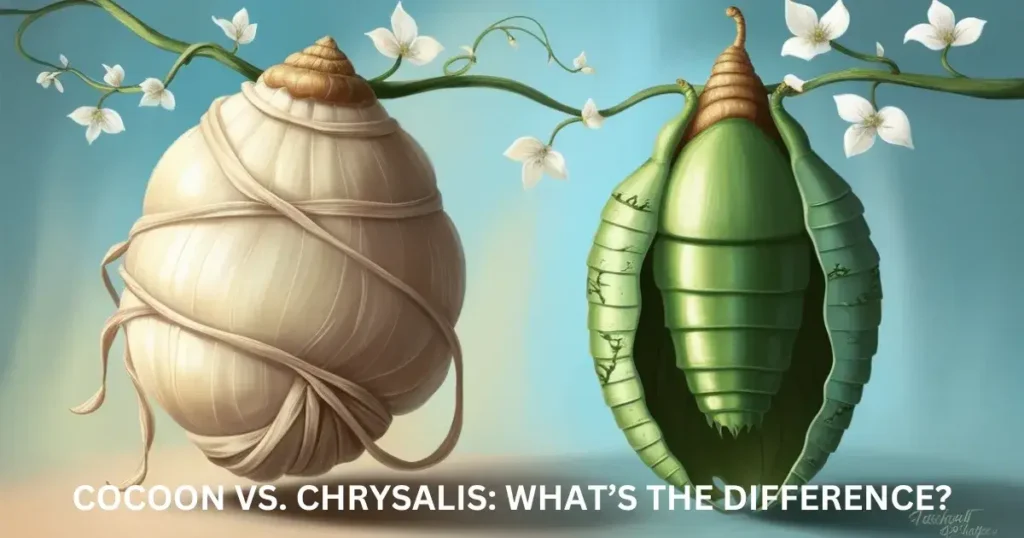
While both “cocoon” and “chrysalis” are protective structures formed during the pupa stage of an insect’s lifecycle, they are different in several key ways. The confusion between the two terms often arises because they both refer to the stage in an insect’s transformation, but they apply to different types of insects.
Cocoon:
- Made by: Moths, caterpillars, and certain other insects.
- Material: Primarily silk.
- Structure: Soft, often fibrous, and usually envelops the pupa entirely.
Chrysalis:
- Made by: Butterflies.
- Material: A hard, outer shell, not made of silk.
- Structure: Often a smooth, leathery, or hard outer casing that encloses the pupa, but it’s not as flexible or protective as a cocoon.
Key Difference:
The key difference is that cocoon refers specifically to the silk covering created by moth larvae, while chrysalis is the term for the hardened pupa stage of a butterfly. The cocoon acts as a cocoon-like protective case, while the chrysalis is a rigid, more durable shell that doesn’t wrap the pupa entirely.
Example Sentences:
- “The cocoon of the moth is a soft, silk structure.”
- “The butterfly emerged from its chrysalis, ready to spread its wings.”
Synonyms for “Cocoon”
Here are some synonyms for “cocoon” when used in the context of insects:
- Pupa
- Chrysalis
- Larva
- Silk structure
- Protective casing
- Encasement
- Covering
- Shelter
- Exoskeleton
- Metamorphosis shelter
In a figurative sense, cocoon can be synonymous with:
- Sanctuary
- Refuge
- Haven
- Retreat
- Isolation
- Comfort zone
- Shell
- Safe space
- Escape
- Self-care
Comparison Table: Cacoon or Cocoon?
Here’s a side-by-side comparison to help you understand the differences between “cacoon” and “cocoon.”
| Aspect | Cacoon | Cocoon |
|---|---|---|
| Definition | A misspelling or botany-related term. | A protective casing formed by larvae during metamorphosis. |
| Context | Used incorrectly in most cases; rare in botanical contexts. | Common in entomology and figurative language. |
| Usage | Rarely used; often a mistake. | Widely used in both biological and metaphorical contexts. |
| Domain | Botany (Fevillea cordifolia) | Entomology, Biology, Psychology, Metaphor |
| Common Errors | Misspelling of “cocoon.” | N/A |
When to Use Each Term
When to Use “Cacoon”
- Botanical context: If you’re discussing the plant Fevillea cordifolia, you may encounter “cacoon”. This is rare, but in botany, “cacoon” can refer to this medicinal plant.
- Avoid using cacoon when discussing insects or transformation.
Use of “Cocoon”
- Insect Metamorphosis: Use “cocoon” to describe the silk protective casing formed by insects such as moths.
- Metaphorical Use: Apply “cocoon” when referring to isolation, retreat, or transformation (e.g., “cocooning” for personal growth).
- Proper Spelling: “Cocoon” is the correct spelling when discussing either the insect stage or the metaphorical meaning.
Origins of “Cacoon” and “Cocoon”
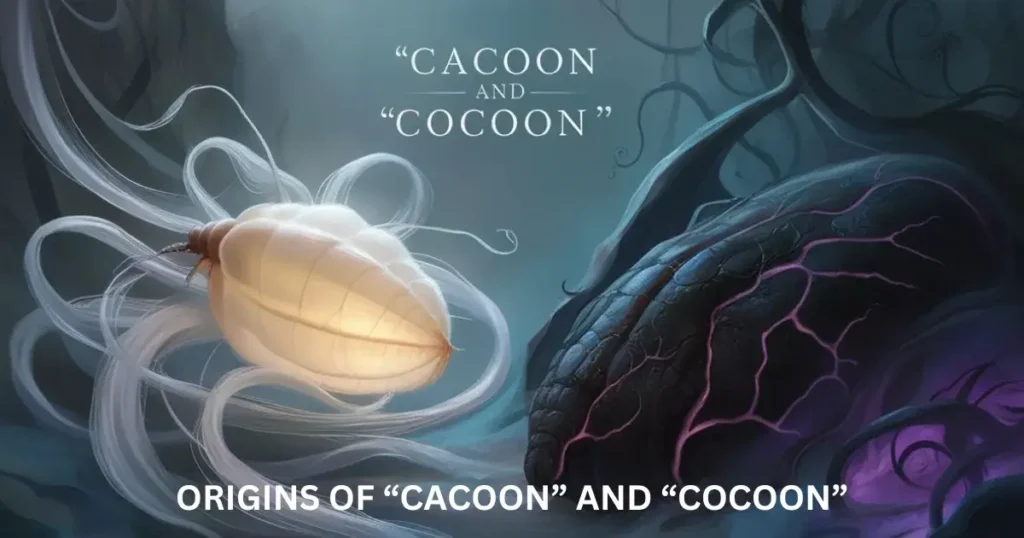
The Origin of “Cacoon”
The term “cacoon” is most likely a misspelling of the word “cocoon”, driven by the similarities in sound. It’s easy to see how the two words might be confused, especially when spoken quickly or in casual conversation. Phonetic similarity plays a major role in the creation of misspellings, and this is one of those cases where the brain substitutes a letter or changes the spelling to align with how the word sounds.
While “cacoon” is often seen in informal writing or on social media, it’s not a recognized word in standard dictionaries. It is simply an error, a case of a commonly misheard or misremembered term. Therefore, “cocoon” remains the correct spelling and usage, both in its literal and metaphorical forms.
The Origin of “Cocoon”
The word “cocoon” has a much richer historical background, rooted in language and biology. The term comes from the French word “cocon,” which refers to a silk capsule or cover spun by certain insects during their pupal stage. “Cocon” itself was derived from the Latin word “cocconus,” which has the same meaning.
From a linguistic perspective, the word “cocoon” has always been associated with the biological phenomenon of insects creating protective casings around themselves during metamorphosis. The word became common in English around the 17th century as entomology (the scientific study of insects) gained more prominence.
In biological terms, cocoons serve as a protective structure, providing a safe environment for insects like moths and caterpillars as they undergo the transformation into their adult forms. This process of metamorphosis is one of nature’s most fascinating, and the “cocoon” plays a crucial role in it.
Why “Cocoon” is the Correct Spelling
Linguistic Reasons
“Cocoon” is the correct spelling based on both its etymology and its consistent usage throughout history. The word maintains its original form from French and Latin, where the double “o” was already established. The spelling reflects its biological roots, preserving the relationship between the word and its natural significance.
In linguistics, consistency in spelling helps with communication, as it ensures that readers and speakers understand the term correctly. Over time, spelling variations such as “cacoon” or “cocoonn” have been seen in informal contexts, but they are not widely accepted in academic or professional writing. The “cocoon” spelling has remained the standard, making it the correct choice in formal contexts.
Historical and Cultural Influences
The spelling of “cocoon” has also been shaped by its cultural and historical references. The cocoon appears in literature, science, and art, often symbolizing transformation, growth, and change. This metaphorical use of “cocoon” in literature helped solidify the word’s association with metamorphosis and personal development.
Throughout history, cocoons have also been of significant economic importance, especially in silk production. The domestication of silkworms (which create cocoons) was key to the growth of the textile industry in ancient China and later in Europe. As a result, the word “cocoon” has carried a strong historical and cultural significance, further solidifying its usage and spelling in both technical and everyday language.
Common Mistakes with Cocoon Spelling
Misspellings of “Cocoon”
While “cocoon” is widely accepted and understood, there are several common misspellings that often occur:
- “Cacoon”: This is the most common misspelling, likely caused by a phonetic mistake where the second “o” is omitted.
- “Cocoonn”: Adding an extra “n” is another frequent error, likely made by people trying to add emphasis or confuse the word with other similar terms.
- “Coccun”: A less common but still noteworthy misspelling, often arising when the word is written quickly or carelessly.
These mistakes may seem minor, but they can undermine the clarity of your writing. Particularly in professional or academic contexts, using the correct spelling of “cocoon” is essential for ensuring that your writing is credible and precise.
Effects of These Mistakes on Clarity and Credibility
Misspelling “cocoon” (such as with “cacoon”) can diminish the professionalism of your writing, especially when it occurs frequently. It can create a sense of inaccuracy, and readers may question the reliability of the source. When you take care to use the correct spelling, it shows attention to detail and enhances your overall writing quality.
How to Avoid the Cacoon Mistake
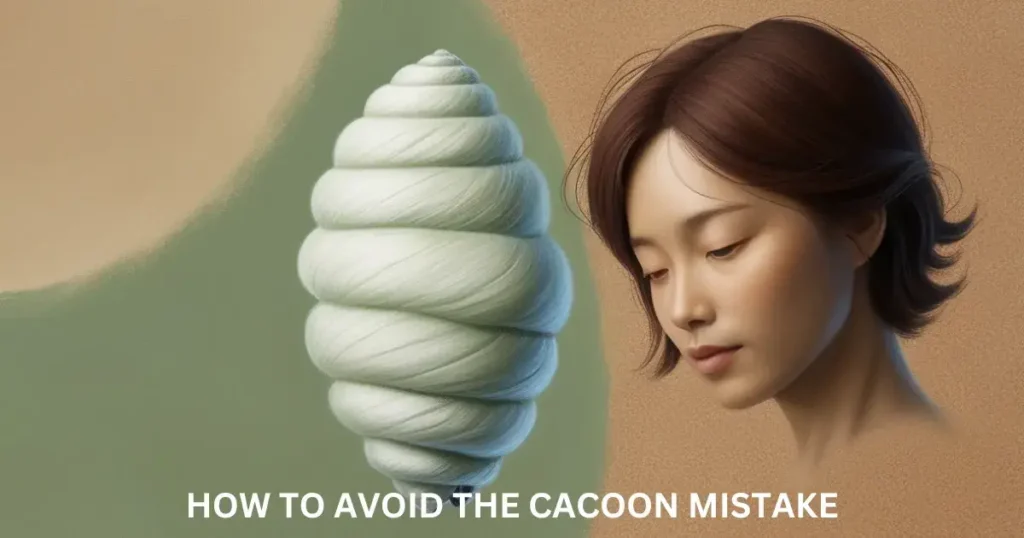
Practical Advice for Ensuring the Correct Spelling of “Cocoon”
To avoid making the common mistake of using “cacoon” instead of “cocoon,” follow these simple strategies:
- Spell-check tools: Use built-in spell checkers in your writing software or word processor. These tools can catch many common misspellings, including “cacoon,” and suggest the correct form, “cocoon.”
- Proofreading: Always take the time to proofread your writing. When reviewing your work, pay close attention to tricky words like “cocoon.” Reading your text aloud can also help you spot errors you may have missed visually.
- Context clues: Be mindful of the context in which you’re using the word. If you are referring to an insect’s protective covering, you can be sure that “cocoon” is the correct choice. If the word doesn’t fit in context (for instance, when talking about a butterfly’s pupa), double-check that you’re not mixing it up with “chrysalis.”
Tips for Remembering the Spelling of “Cocoon”
Here are a few mnemonic tricks to help remember the double “o” in “cocoon”:
- Imagine the shape of a cocoon: Picture the shape of a cocoon. It’s often an oval or rounded form, which resembles two “o”s side by side.
- Double “o” as protection: Since cocoons are protective coverings, the double “o” can be seen as representing extra protection or a “double” layer of security.
- Think of a “double dose” of silk: The extra “o” could symbolize the extra protection that the cocoon provides during metamorphosis, just as the insect gets an additional layer of safety.
Cocoon as a Verb
“Cocoon” can also be used as a verb. In this sense, it means to envelop or surround something or someone in a protective way, much like how an insect wraps itself in a cocoon during its metamorphosis.
- Example: “She cocooned herself in a blanket to stay warm during the storm.”
The verb form conveys the idea of providing a safe, isolated space for protection or comfort. It implies a sense of seclusion, similar to the cocoon’s role in nature.
Shift in Meaning from Noun to Verb
- As a noun, “cocoon” refers to the physical object itself, typically spun by an insect.
- As a verb, “cocoon” takes on a more metaphorical meaning, referring to the act of wrapping up or isolating oneself or something else for protection or comfort.
Psychological and Social Implications of Cocooning
In modern life, the term “cocooning” has evolved into a psychological and social concept. It refers to the human tendency to retreat into one’s own space, particularly during times of stress, personal growth, or recovery.
- People may “cocoon” themselves during a tough period, seeking isolation to recharge and reflect. This can involve spending time at home, avoiding social interaction, or indulging in activities that provide comfort and safety.
Psychologically, “cocooning” can be both positive and negative:
- Positive: It allows individuals to rest and recover from emotional challenges.
- Negative: Extended isolation can lead to loneliness or feelings of disconnect from the outside world.
The Lifecycle of a Cocoon: From Larva to Butterfly
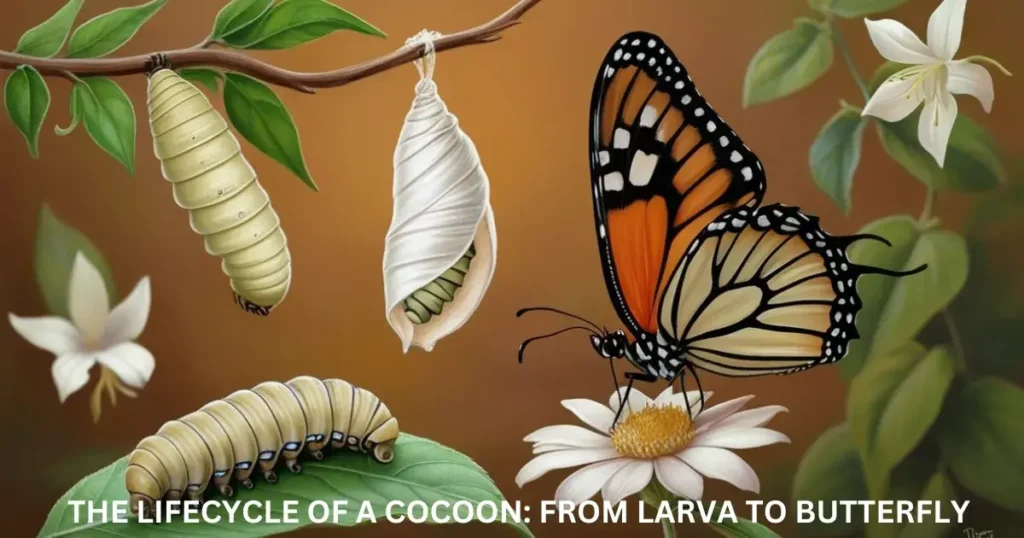
The cocoon plays a critical role in the life cycle of many insects, particularly moths. This protective casing allows the insect to transition from a larva (caterpillar) into an adult butterfly or moth.
Phases of Metamorphosis
- Larva (Caterpillar Stage): The insect begins its life as a larva, often a caterpillar. This stage involves rapid growth and feeding.
- Pupa (Cocoon Stage): The larva forms a cocoon or chrysalis, depending on the insect. Inside, it undergoes metamorphosis, transforming into an adult.
- Adult: The adult insect emerges from the cocoon or chrysalis, ready to reproduce and begin the cycle anew.
Metaphorically, this process represents personal growth and transformation. Just as an insect changes from one form to another inside its cocoon, humans often go through periods of change or growth, emerging stronger on the other side.
Everyday Usage Examples
Here are a few examples to make sure you’re using cocoon correctly:
- “The caterpillar spun a cocoon around itself to protect itself during metamorphosis.”
- “After a busy week, she decided to cocoon in her living room and catch up on her favorite books.”
- “The moth cocoon was fragile, and you could see the pupa beginning to form inside.”
- “The transformation from larva to butterfly happens inside the cocoon.”
Conclusion
To recap, “cocoon” is the correct term when referring to the protective casing formed by insects like moths and caterpillars, or even in a metaphorical sense of personal transformation or retreat. “Cacoon,” however, is a misspelling or a rare term used in specific botanical contexts. Knowing the right time and place to use each term is important for clear, effective communication.
The next time you find yourself asking “Cacoon or Cocoon?”, remember that cocoon is your go-to word in most cases. Whether you’re discussing insect metamorphosis, the metaphor of cocooning, or learning about moth cocoons, always double-check the spelling to avoid common errors. Understanding these distinctions ensures you’ll be using language accurately and confidently.
So, now you know the difference—no more wondering about “cacoon or cocoon” in your writing!
FAQs
What is a Cacoon?
A “cacoon” is typically a misspelling of “cocoon,” though it can also refer to a medicinal plant in some botanical contexts.
What is the correct spelling of cocoon?
The correct spelling is “cocoon”, which refers to the protective casing formed by insects during their metamorphosis.
What does cocoon mean?
A cocoon is a silky protective covering created by certain insects like moths and caterpillars during their pupal stage.
What does like a cocoon mean?
The phrase “like a cocoon” often refers to a state of being enclosed or isolated for protection or personal growth.
What is a chrysalis vs cocoon?
A chrysalis is the pupal stage of butterflies, whereas a cocoon is the silk covering spun by moths and other insects.
What is a cocoon slang?
In slang, “cocoon” refers to retreating into a safe, isolated space, often for rest or self-reflection.

This author is a passionate linguist and grammar enthusiast, dedicated to helping individuals master the art of language. With years of experience in teaching and editing, she brings clarity and precision to every sentence. Tina’s mission is to empower writers of all levels to express themselves with confidence and excellence.

